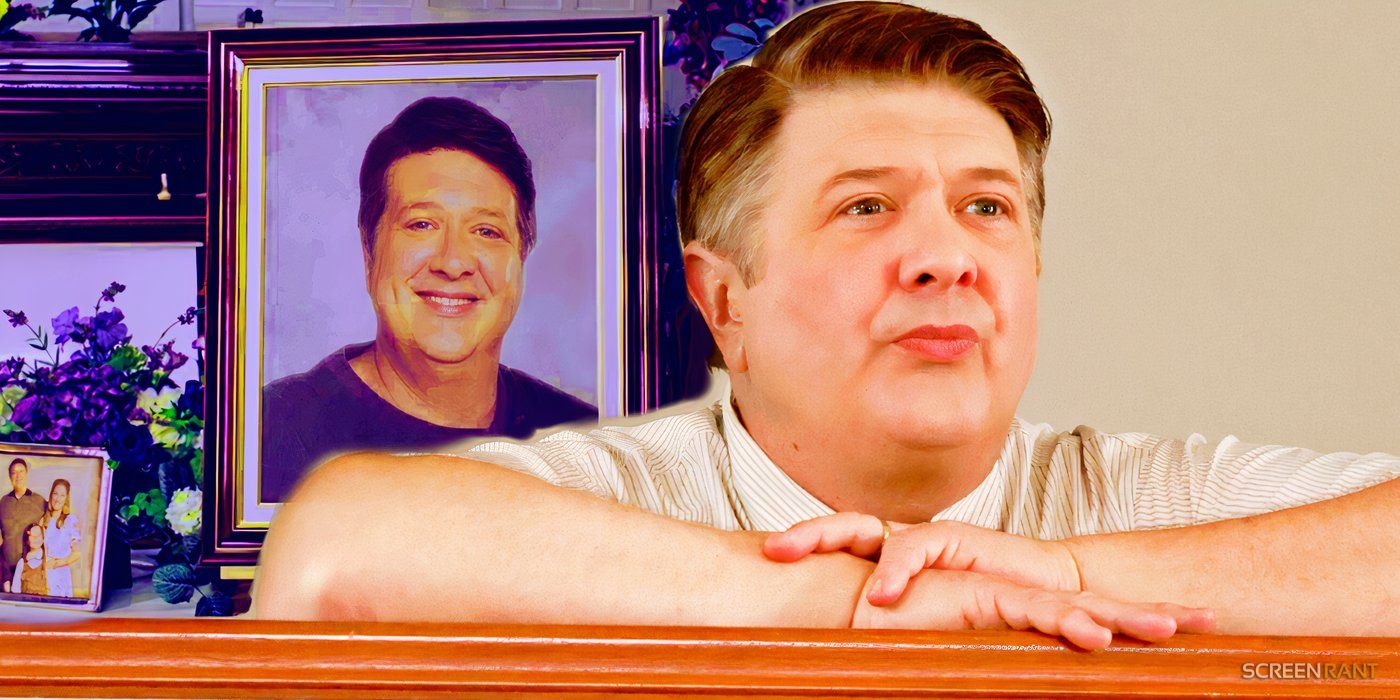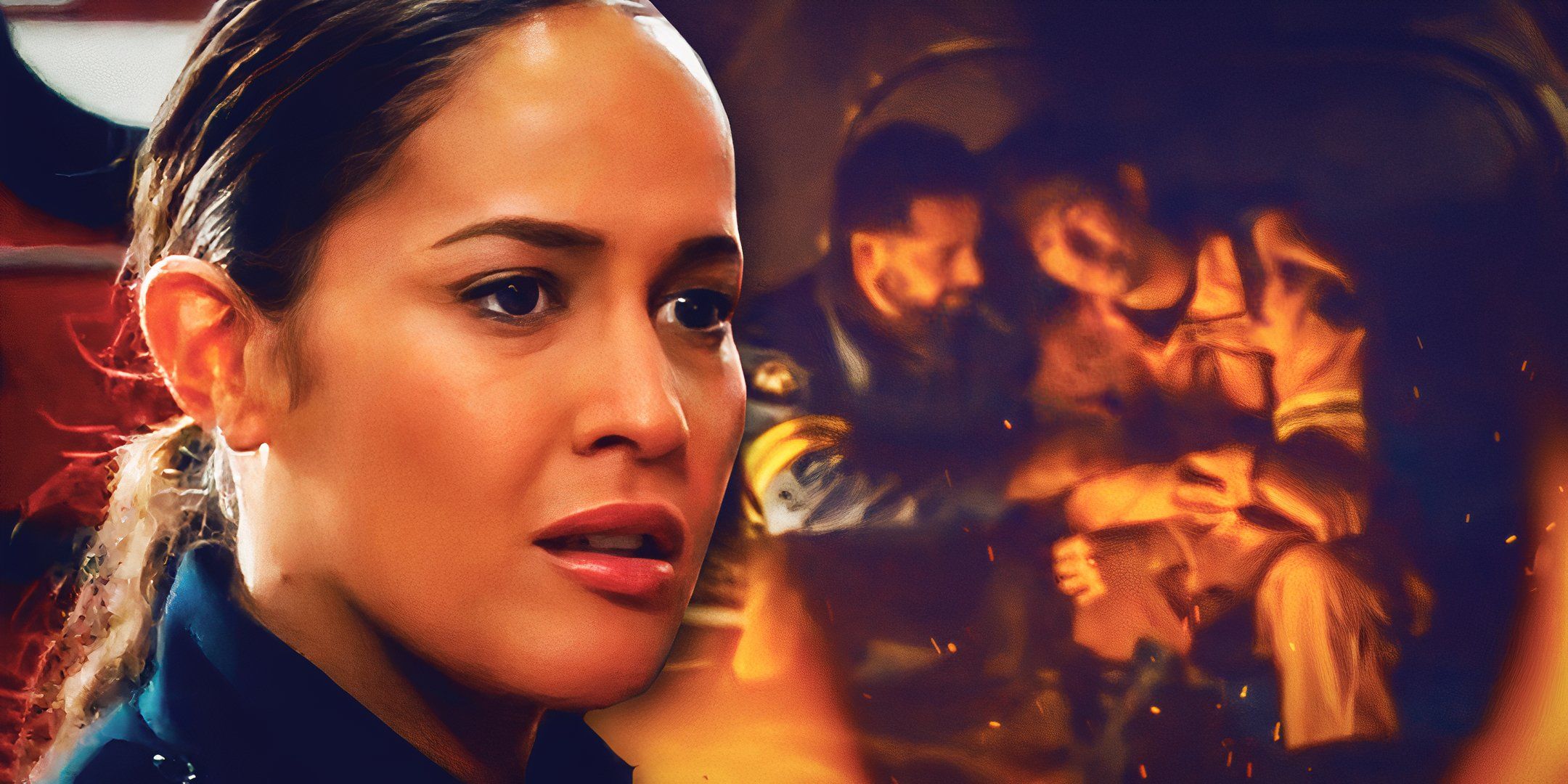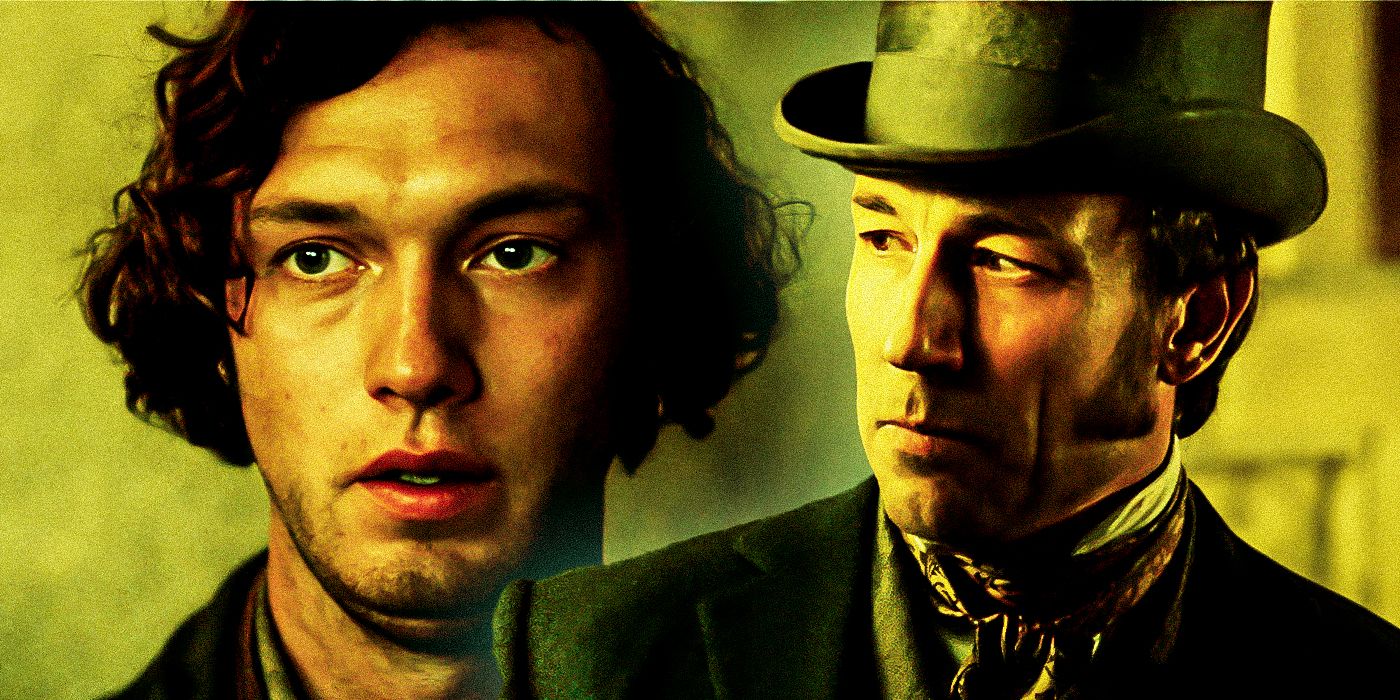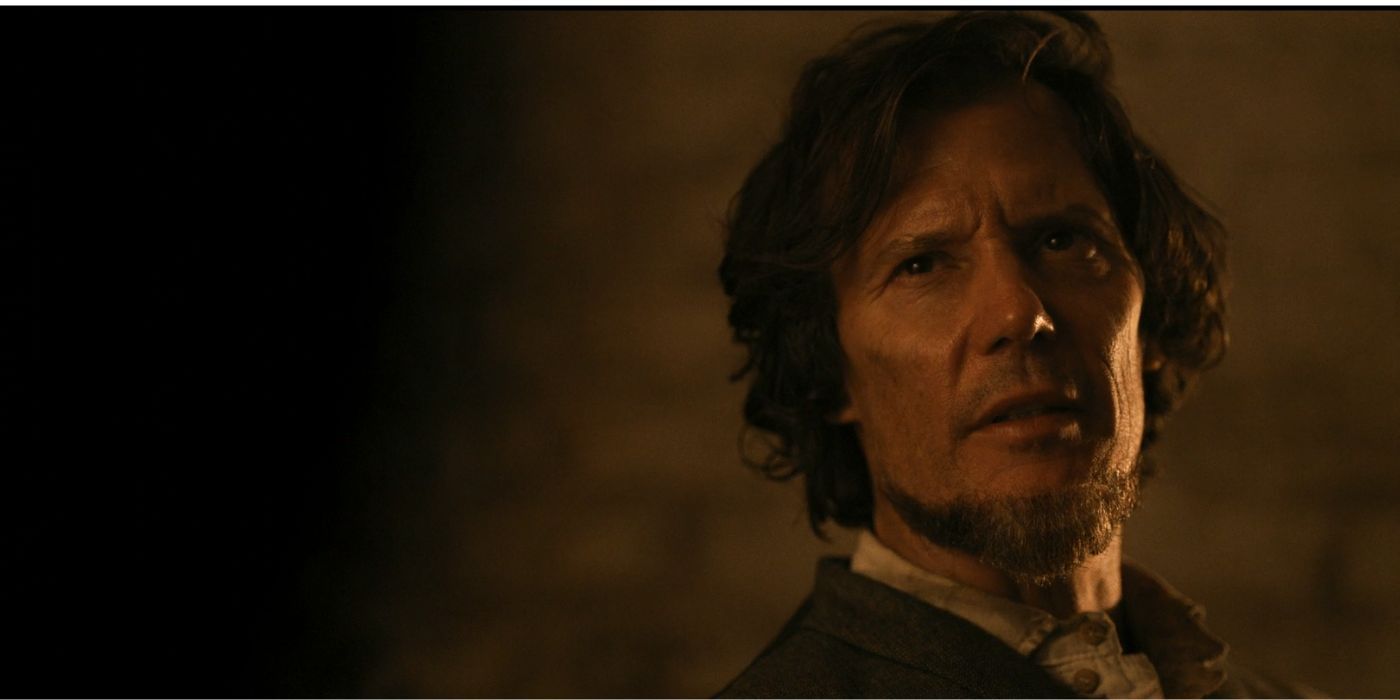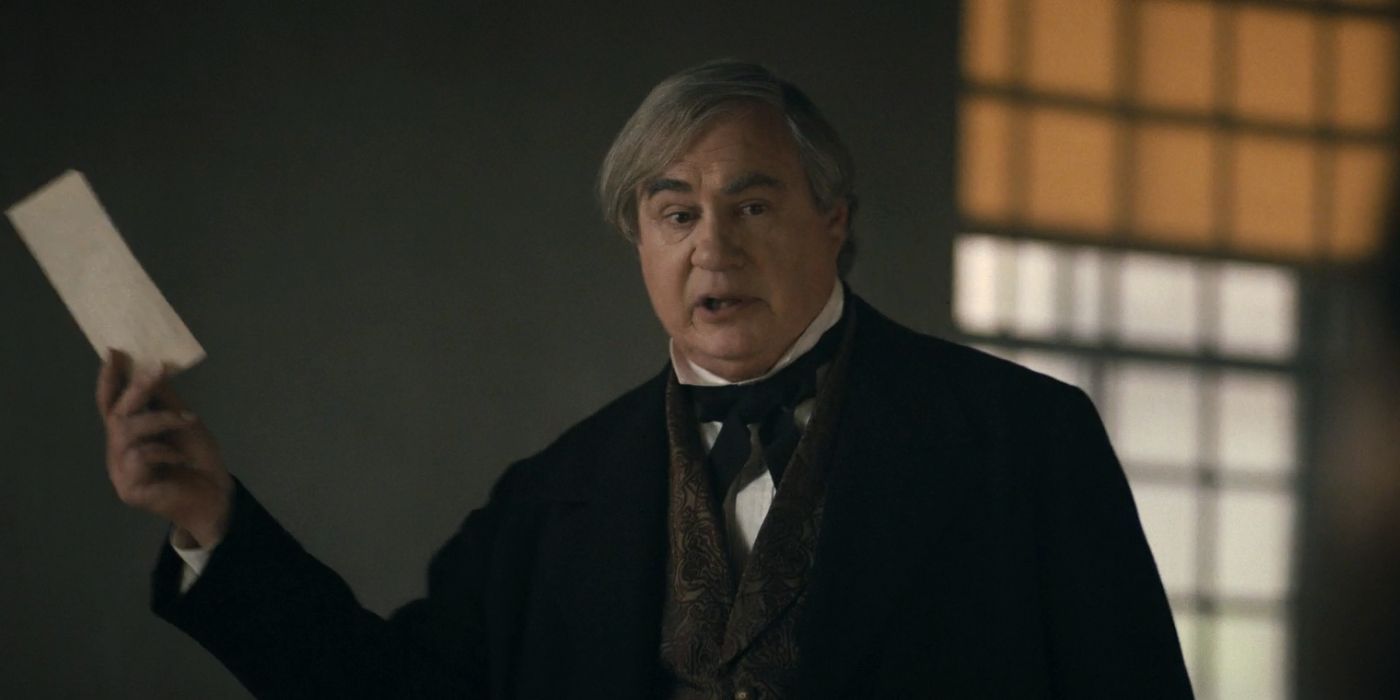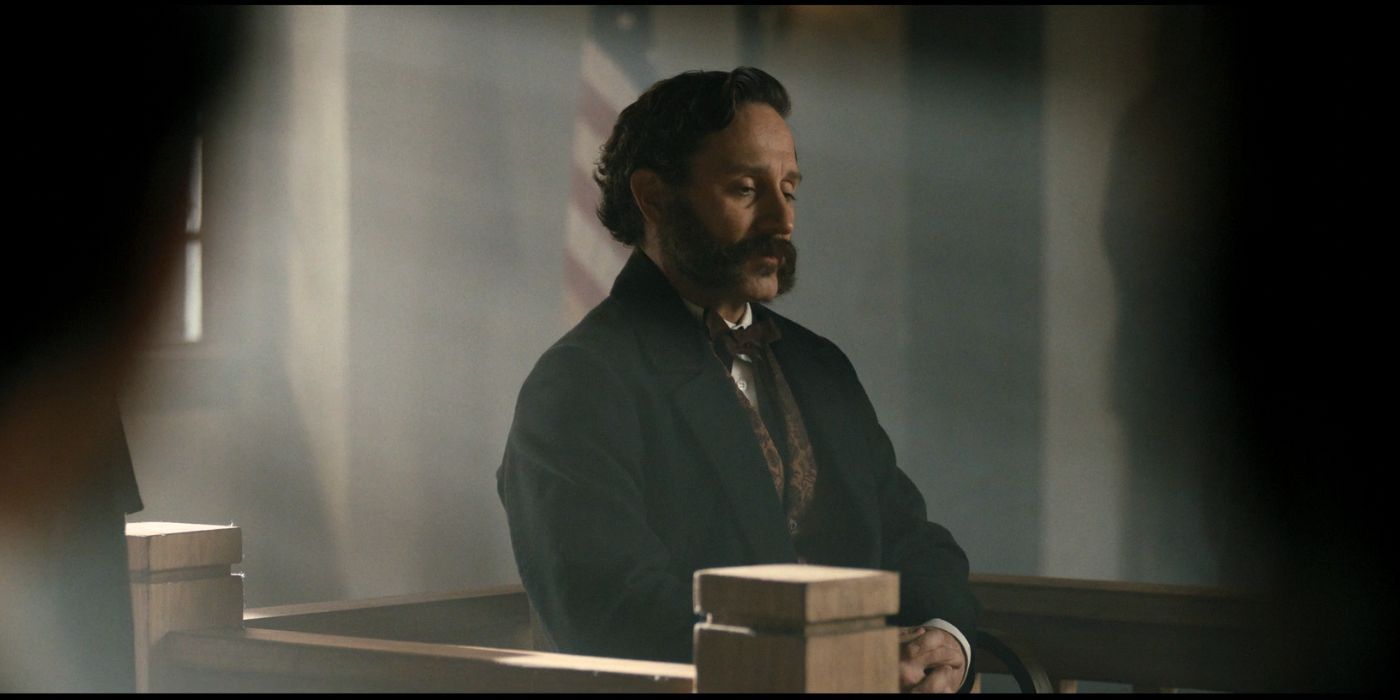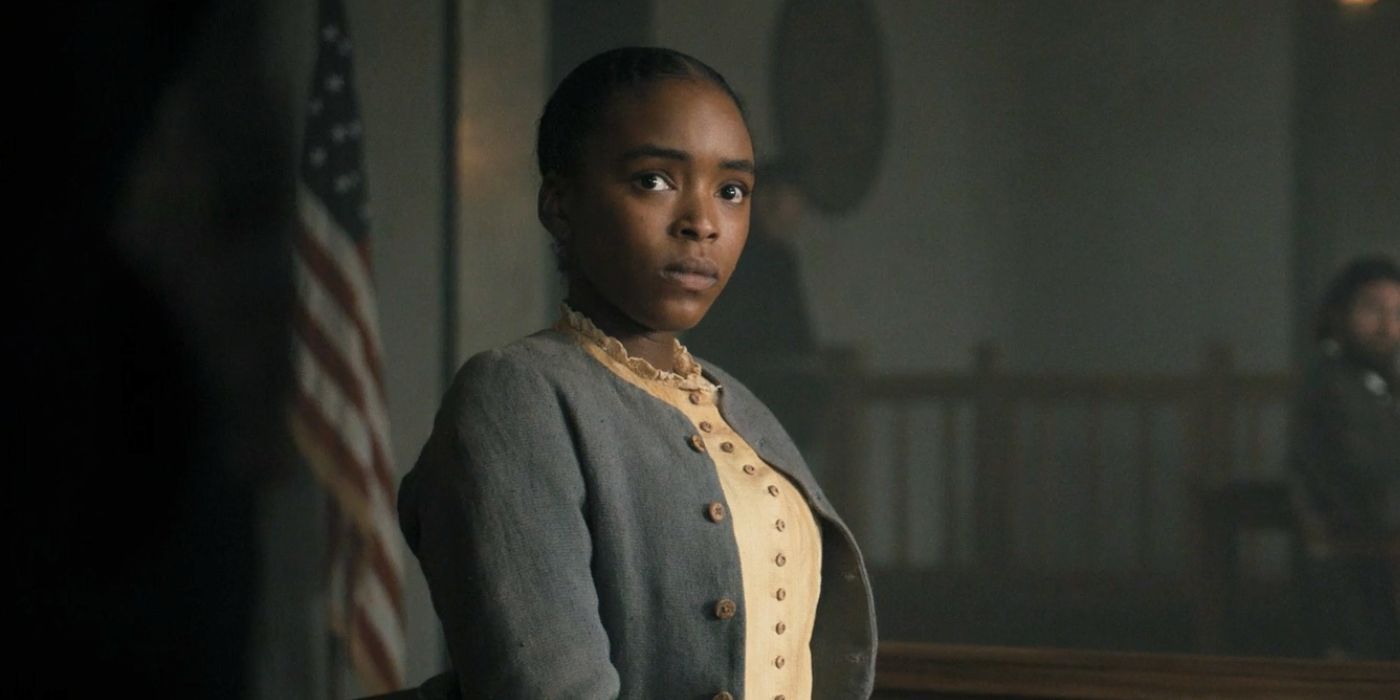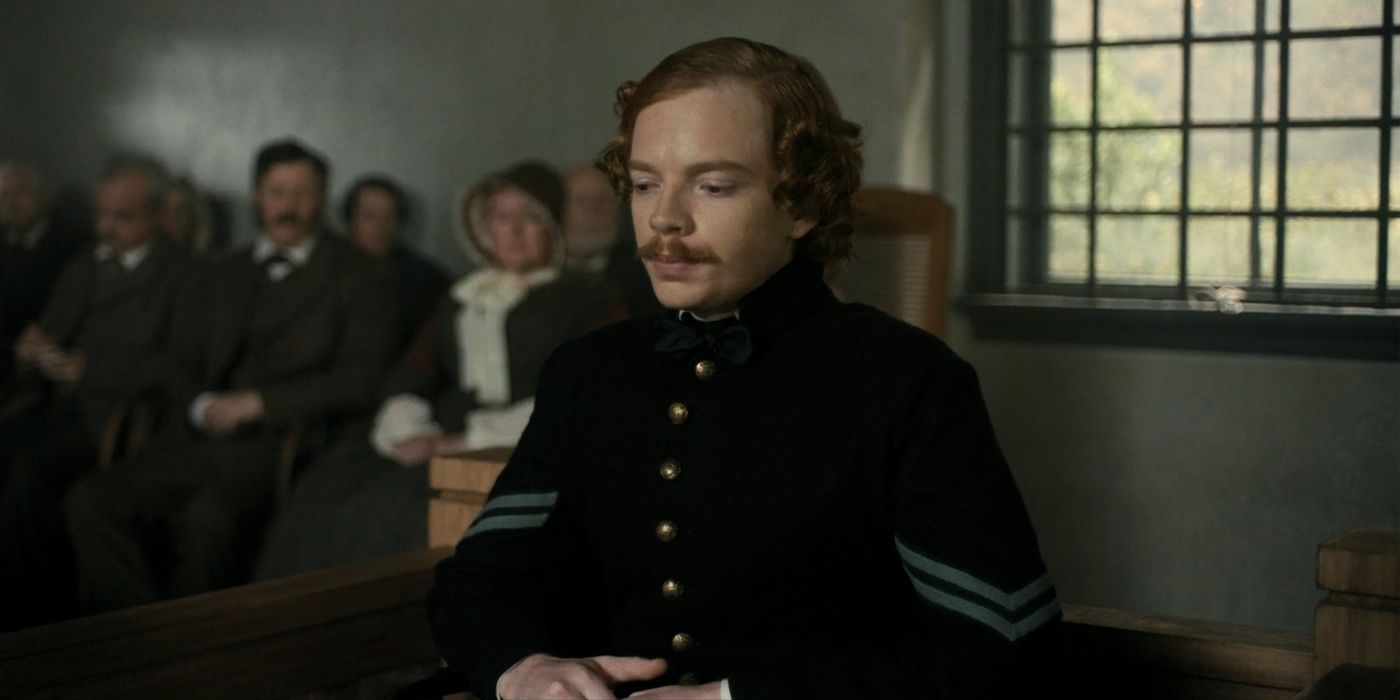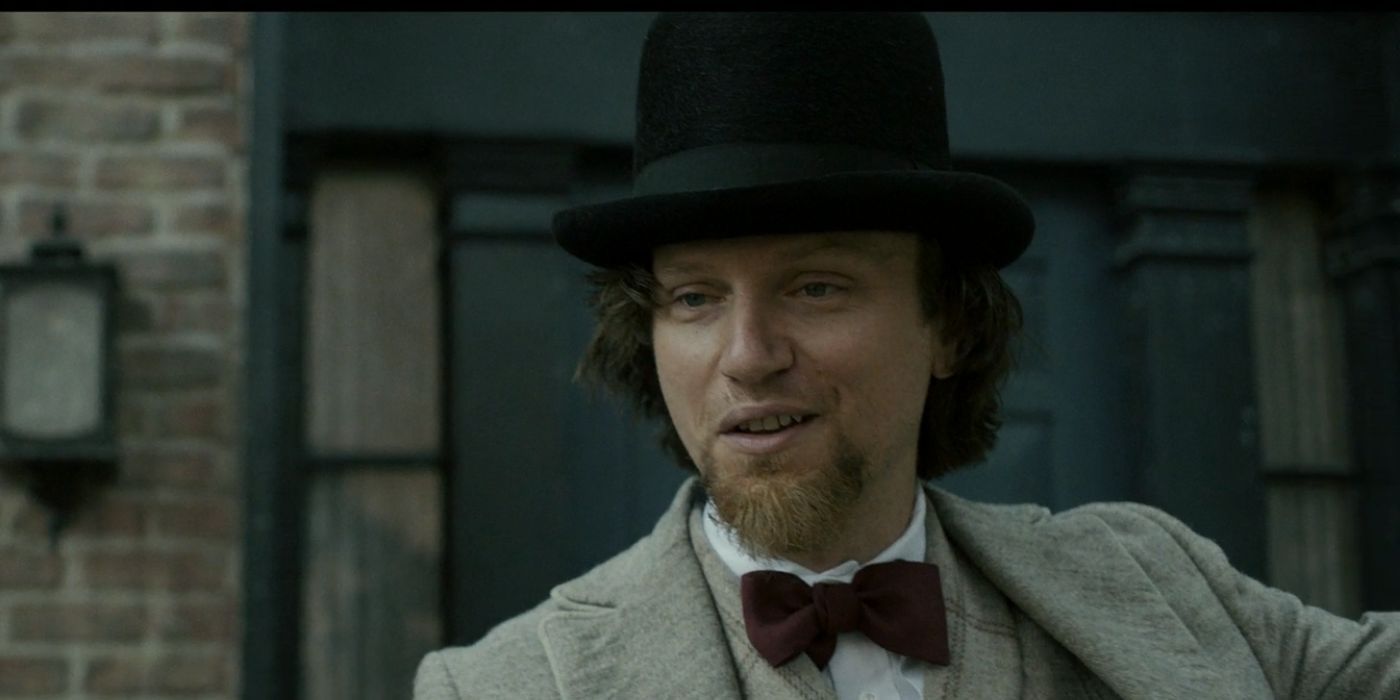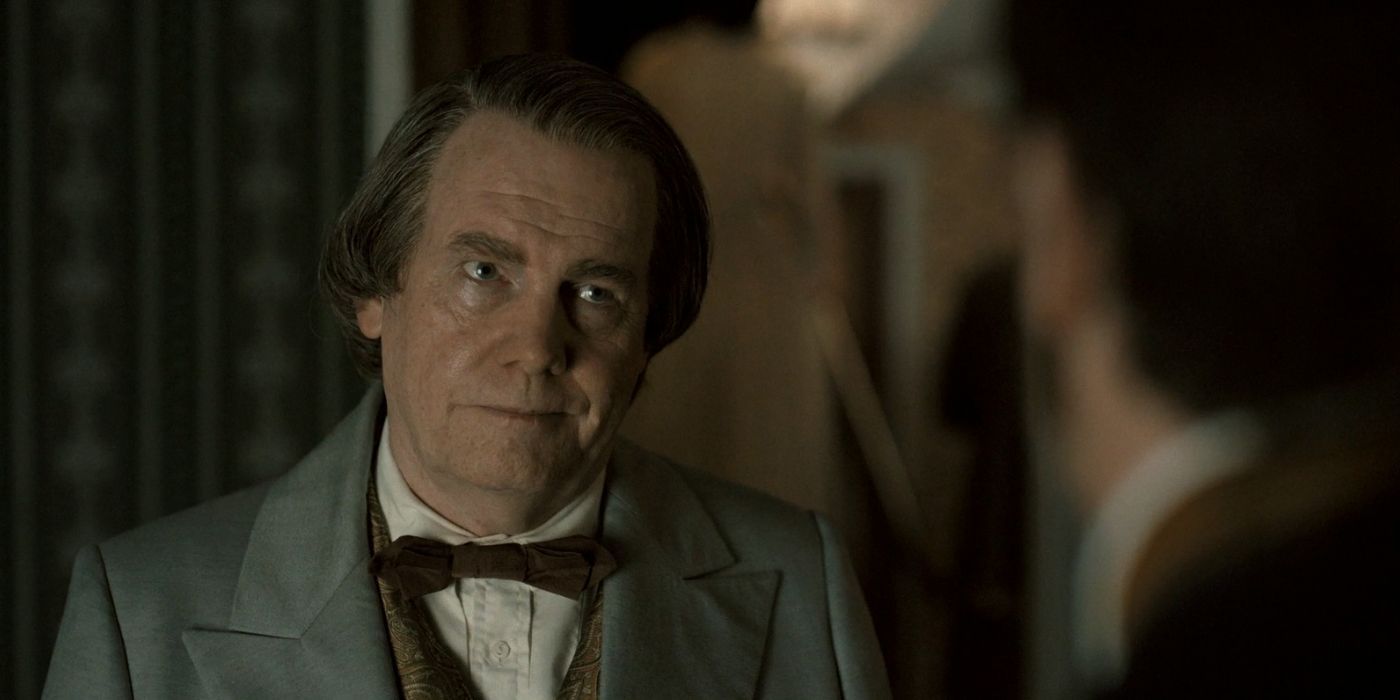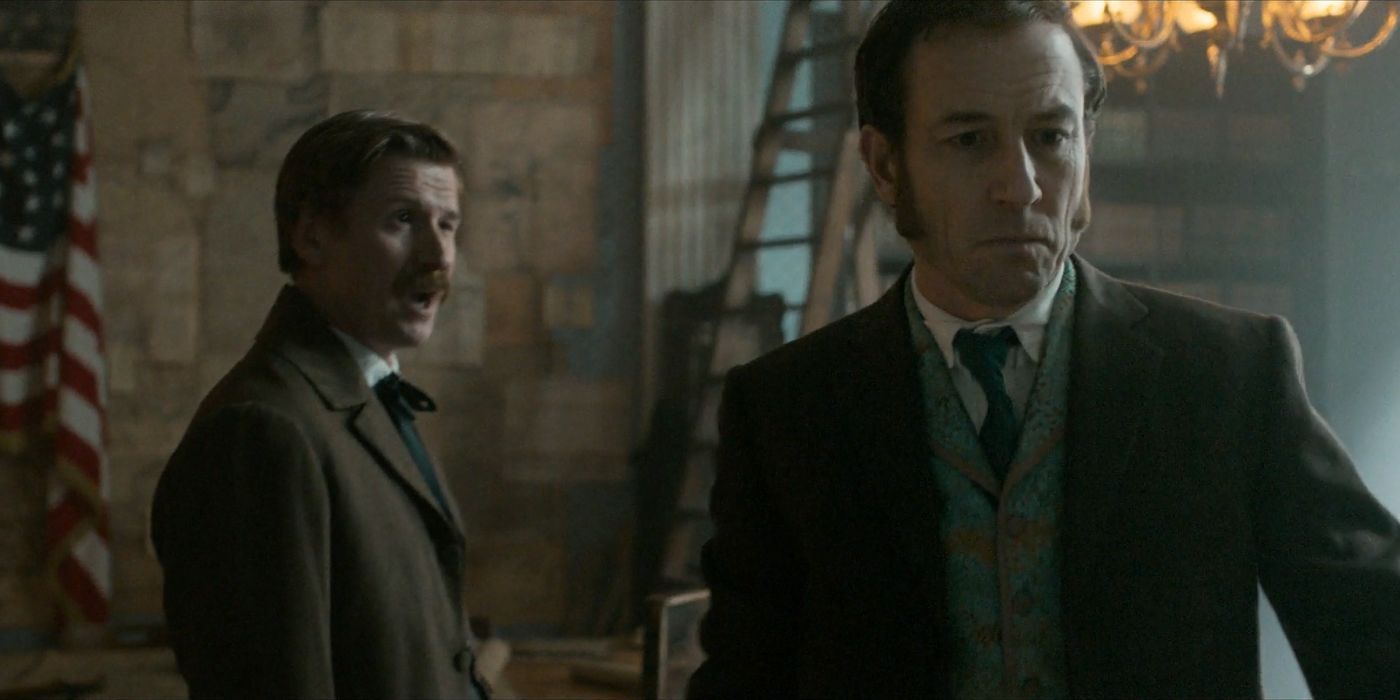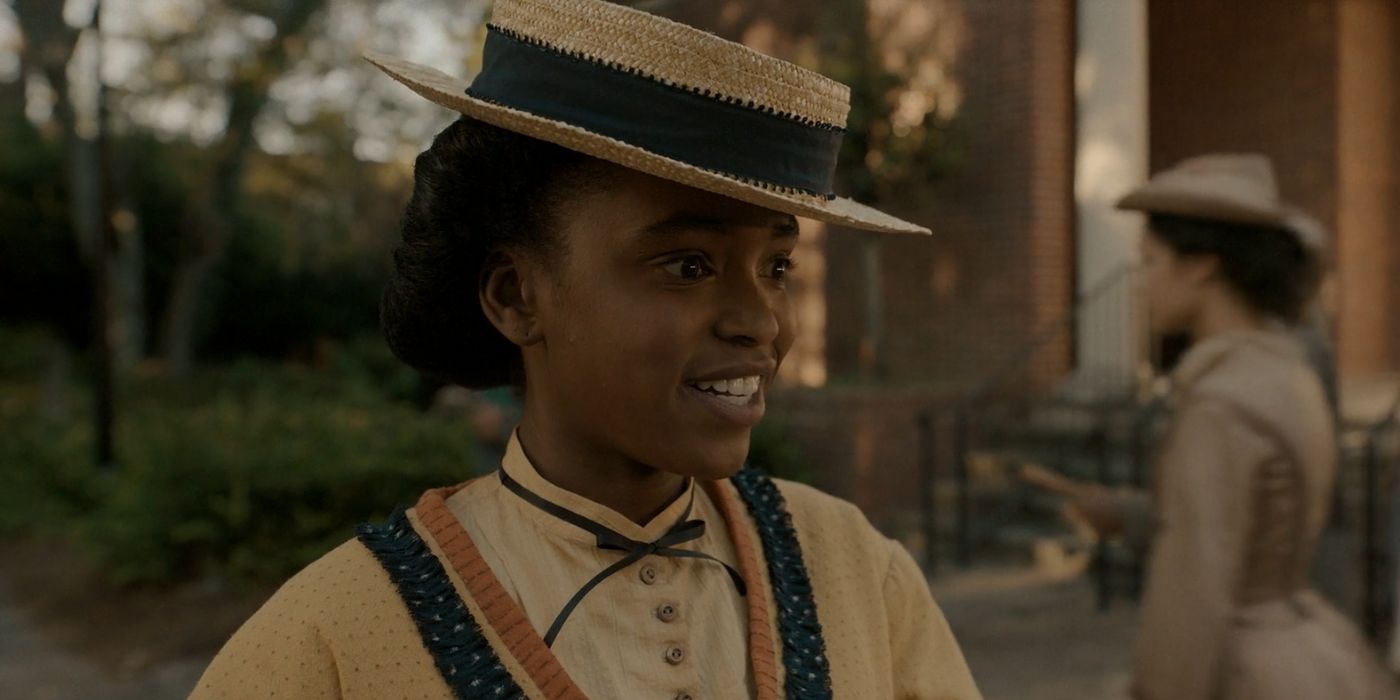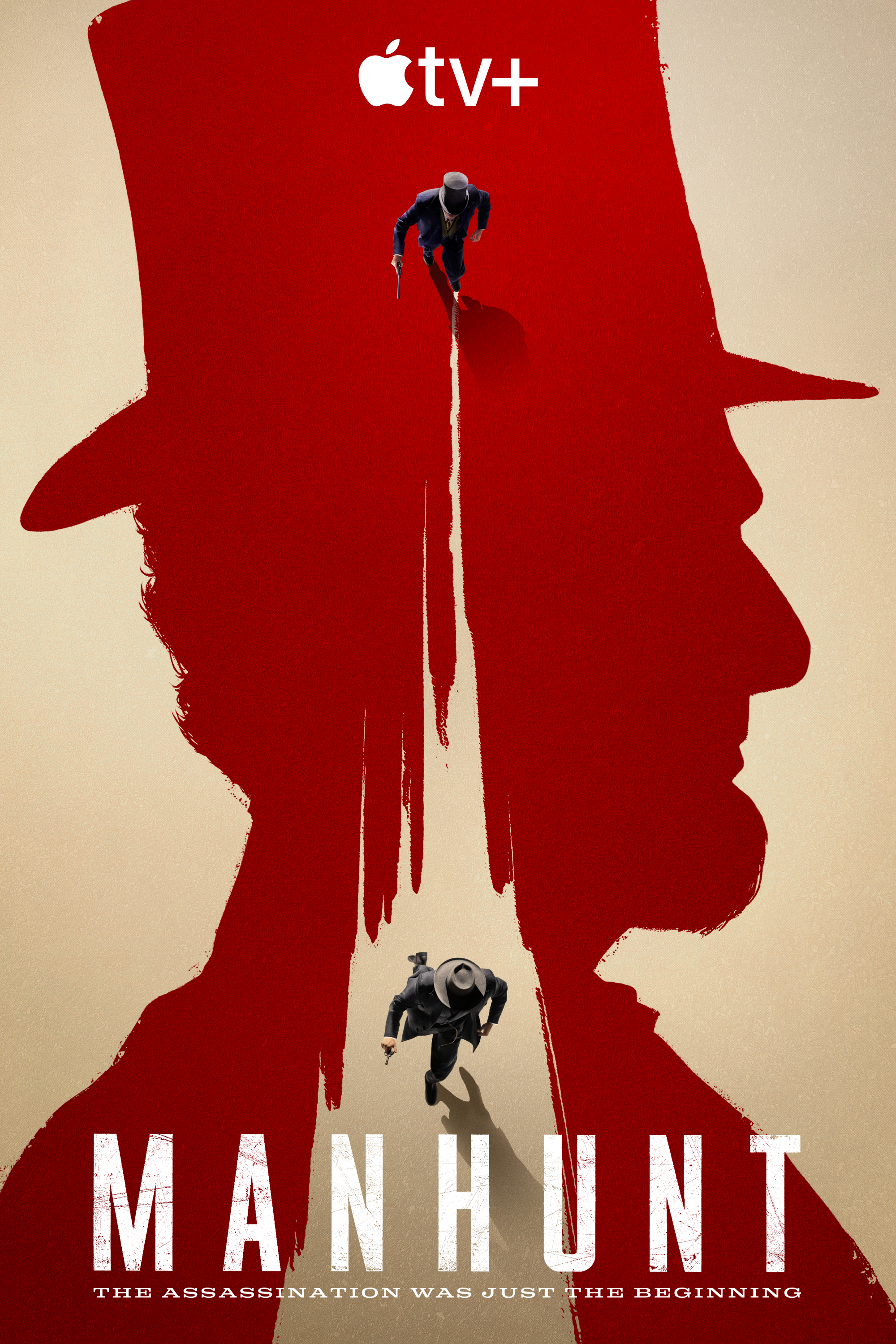After Manhunt episode 6 saw Secretary of War Edwin Stanton's desperate pursuit of John Wilkes Booth come to an end, the show's focus shifted to the conspirators who supported Booth, both on the night of the assassination and the months leading up to it. Manhunt creator Monica Beletsky blended fact and fiction in the show's depiction of the trial covering Stanton's charges of a grand conspiracy. As was the case for the entire show, the narrative departed from reality in a few places to put emphasis on particular characters and elevate the drama.
More than any other chapter of the story, Manhunt episode 7 focused on the long-term effects of John Wilkes' Booth's assassination of Abraham Lincoln. While the trial at the episode's center resulted in consequences for co-conspirators like David Herold and Dr. Samuel Mudd, the Confederate agents behind the larger conspiracy that Stanton strove to uncover never faced a commensurate punishment for their actions. While the tragedy of the real-world effects highlighted in the show was depicted accurately, some of the details were altered for the sake of the show's narrative.
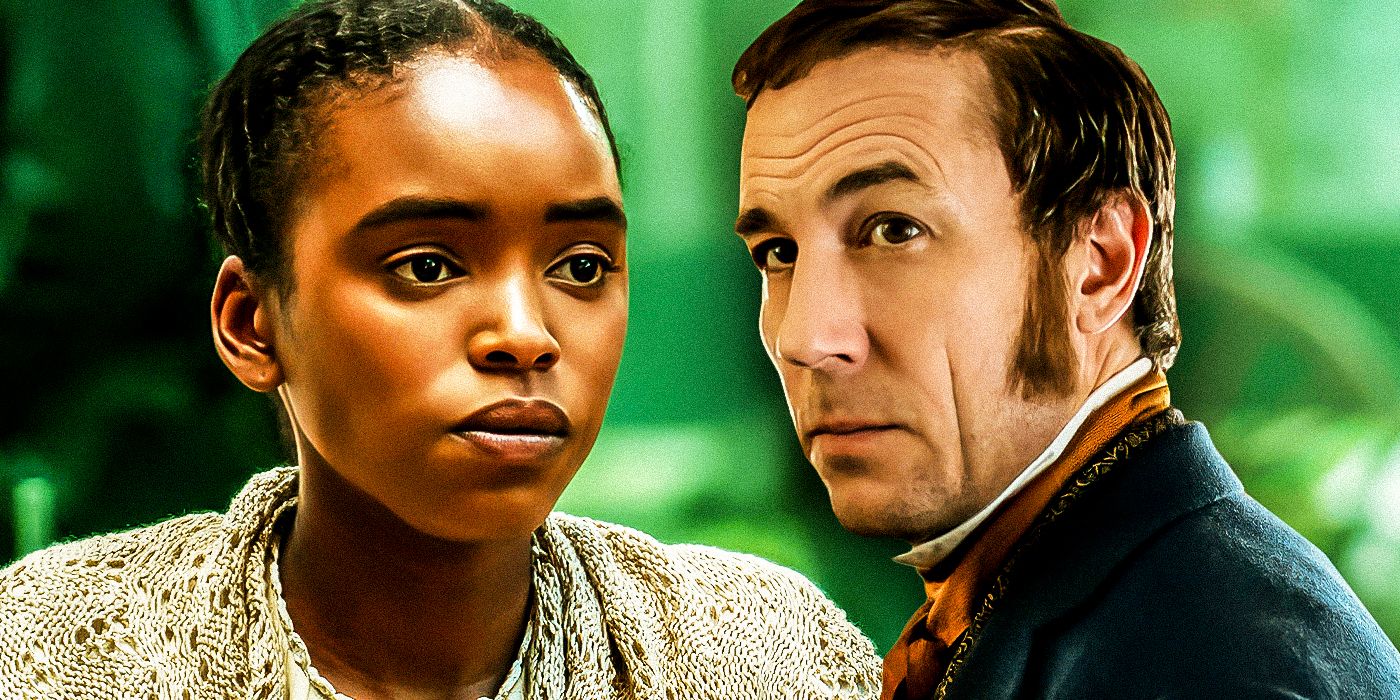
Manhunt Ending Explained: What Happened To Stanton After The Grand Conspiracy Trial
Despite capturing John Wilkes Booth, the battle for justice and for Reconstruction was only just beginning for Tobias Menzies' Edwin Stanton.
9 Stanton Never Questioned Jefferson Davis
There is no evidence Stanton ever visited Davis' cell.
Perhaps the single most significant departure from reality that Manhunt has is the role that Edwin Stanton played in tracking down John Wilkes Booth. In the show, Stanton's portrayed as a doggedly determined detective who chases down leads and questions witnesses himself, even at the risk of his own health. While he maintains his role as Secretary of War, he takes a much more involved role in the physical pursuit of Booth and his co-conspirators.
In reality, Stanton coordinated the efforts required to hunt down Booth, but he did so largely via telegraph and dispatching agents into the field. As a politician and lawyer, the real Edwin Stanton simply didn't have the boots-on-the-ground role that Manhunt gives him. As a result, many of the scenes involving him questioning the individuals involved in the conspiracy himself are fictional. That includes Mary Surratt, George N. Sanders, and in Manhunt episode 7, the former president of the Confederacy, Jefferson Davis.
8 Conover’s “Pet Letter” Never Existed
Conover's most damning piece of evidence was fictional.
One of the most significant pieces of evidence entered into the trial in Manhunt episode 7 is the so-called "pet letter" from Sanford Conover, Agent Lafayette Baker's spy turned double agent. In the letter, Jefferson Davis refers to his "pet", which Conover testifies is a reference to John Wilkes Booth, who is commonly known as Davis' pet in Confederate circles. In the show, that letter is revealed to be an elaborate forgery by Conover, who is exposed as a double agent, master forger and spy. In reality, the letter never existed, as there is no record of a letter like that ever existing.
7 Conover Was Not Edwin Stanton’s Star Witness
The real Edwin Stanton did not place nearly as much importance on Conover's testimony.
In Manhunt episode 7, Conover was initially set up to be Edwin Stanton's "star witness", who could provide definitive testimony directly connecting John Wilkes Booth to both Jefferson Davis and the "Confederate Clique" in Montreal, led by George N. Sanders. His reliability is called into doubt when he supposedly confuses the dates of an important meeting that he referred to in his testimony. Conover's inconsistent testimony and reputation as a forger is depicted as one of the most important reasons that the grand conspiracy charges resulted in an inconclusive verdict.
Conover's real name was Charles Durham, one of three aliases that he frequently used in his capacity of a spy.
Per UMKC School of Law, the real Sanford Conover testified similarly about the connections between the Confederate Secret Service in Montreal, Jefferson Davis and Booth. However, he was far from a "star witness" in the proceedings. Conover's testimony was widely considered to be perjurious at the time, and has since been attacked by historians as being false. He was far from the key witness that he is depicted as in Manhunt.
6 Mary Simms Didn’t Play Such A Significant Role In The Trial
While she did testify, she was not a driving force behind Stanton's conspiracy case.
The real Mary Simms did play a large role in making sure that Dr. Samuel Mudd faced justice for his role as a Confederate sympathizer and his connection to the Confederate Secret Service. While she was important in the conviction of Mudd, Mary Simms' testimony had little to do with the larger grand conspiracy charges. She was one of a number of freedmen and freedwomen who testified against Mudd and the other conspirators over the course of the trial.
Throughout Manhunt, Mary Simms was given a much larger role because she acted as a representation of not only the many brave men and women who testified in the trial, but also as a representation of all former slaves in post-Civil War America. Her experiences in the show are important in providing the perspective of a largely underrepresented portion of the population from contemporary discussions of Reconstruction, particularly in the time period immediately following Lincoln's assassination. Simms was very important to how creator Monica Beletsky examined the sociopolitical climate in Manhunt, but she wasn't actually that important to the trial.
5 Louis Weichmann Didn’t Support Mary Simms’ Testimony
There is no evidence Weichman ever even spoke with Mary Simms.
Perhaps the most touching scene in Manhunt episode 7 comes at the end of Louis Weichmann's testimony, during which he proclaims that he believes Mary Simms' testimony, as it aligns with the conversations that he heard himself in relation to the defendants. That was an important moment in the show's trial, as the defense lawyers had already been attacking Mary's testimony based on her lack of education. Having the support of a white soldier like Louis Weichmann was important in elevating the impact of her testimony, as the words of an uneducated black woman likely fell on many deaf ears in the year 1865.
All episodes of Manhunt are now streaming on Apple TV+.
In reality, neither Weichmann's support of Mary on the witness stand nor their heart-to-heart before his testimony ever happened. Weichmann did play an important role in the trial, as he was able to provide a connection between Booth and the Confederate Secret Service member John Surratt as a boarder at the Surratt boarding house in Surrattsville, which Booth frequented. It simply is unlikely that Stanton's witnesses ever interacted in any meaningful capacity, as is shown in Manhunt.
4 John Surratt Didn’t Brag About His Connection To The Assassination
Surratt did go on tour after returning to the States, but it was to proclaim his innocence.
In the epilogue of Manhunt episode 7, it's revealed that John Surratt eventually returned to the United States, where he was tried in civil court and escaped any punishment. As the show's on-screen text states, Surratt toured around the South bragging about his role in the assassination and his connection to Booth. In reality, John Surratt did make a speech in Maryland where he revealed his connection to a plot with Booth to kidnap Lincoln, which never came to pass. However, the speech was not boastful; Surratt maintained his innocence in the assassination plot, and called Weichmann a perjurer.
3 Stanton Never Suspected Andrew Johnson Was Connected To The Conspiracy
Stanton's cryptic threat to Johnson likely never happened.
Andrew Johnson's Reconstruction plan was a twisted, warped version of Lincoln's original vision, and directly resulted in much of the hatred and violence that black Americans endured in the following century. As a racist, Confederate-sympathizing former slave owner, there were many who suspected that Johnson had something to do with Lincoln's assassination, especially as his potential assassin and Booth co-conspirator, George Atzerodt, never actually made an attempt on his life. Agent Lafayette Baker encourages Edwin Stanton to look into Johnson early in the investigation of the grand conspiracy, although Stanton barely entertains the notion.
His potential involvement is brought up again in Manhunt episode 7 when Johnson removes Stanton from the office of Secretary of War. Stanton reminds Johnson that he does have his own suspicions, saying "I could have accused you." Johnson's defiant response almost implies that perhaps he should have: "But you didn't." In reality, there is no record that Stanton ever believed that Johnson had anything to do with the assassination, although their enmity as political and idealogical opponents was very real.
2 Thomas Eckert Didn’t Help Stanton Cover Up The Missing Diary Pages
The diary pages have been lost to history.
The content of the missing pages of Booth's diary remains one of the most vexing mysteries in American history. At some point between the removal of the diary from Booth's body to the time the diary found its way into the National Archives, at least 18 pages were removed, although there is some debate as to how many meaningful pages were ripped out. Manhunt creator Monica Beletsky chose to directly address the conspiratorial notion that Edwin Stanton himself removed the pages, and in Manhunt episode 6 he is shown removing the pages and burning them.
Stanton's alleged attempted assassination of Jefferson Davis may have been the primary motivation for Booth killing Lincoln.
His assistant, Thomas Eckert, brings up the missing pages again in episode 7, making sure to note that he cleaned out Stanton's hearth the night before, leaving him with a little nod. The implication is that both Stanton and Eckert were aware of what was in the pages, and both wanted them to disappear. While it's been speculated that the diary revealed that Stanton (and by extension Eckert) was involved in Lincoln's assassination, Beletsky posits that the pages might have revealed Booth's motivations, and that Stanton's alleged attempted assassination of Jefferson Davis was the reason he killed Lincoln.
In reality, there is simply no way to ever know what happened to the missing pages unless they resurface. With no knowledge of who tore the pages out or what the pages revealed, it's impossible for any depiction of their fate to be truly accurate. The scene of Stanton burning the pages and Eckert taking care of the evidence elevates the intrigue of Manhunt, but there's no evidence it unfolded that way.
1 Mary Simms Did Not Attend Howard University
There is no evidence Mary Simms ever attended college.
The courageous and driven character of Mary Simms is shown attending Howard University, which is now one of the most prestigious predominantly black schools in the country. However, according to The New Yorker, Mary Simms appeared on the 1900 U.S. census, still living in Bryantown (near where Dr. Mudd's house was) as a 60-year-old cook who was still unable to read or write. Simms' character ending once again represents the experience of newly-freed black Americans, but it seems almost certain that the real Mary Simms never attended college.
Source: UMKC School of Law, The New Yorker


